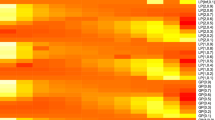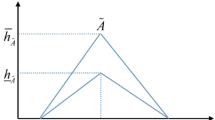Abstract
Perceptual computing (Per-C) is a branch of CWW (Computing with words) that assist people in making subjective decisions. Their applications take linguistic inputs (i.e., words) from the user and return a linguistic output (i.e., word). The perception of these linguistic inputs suffers from uncertainties, for which IT2FSs (Interval Type-2 Fuzzy Sets) are considered better than T1FSs (Type-1 Fuzzy Sets) to capture it. In these applications, the IT2FSs are constructed either by application developers or by consulting experts. Due to the manual introduction of biases, these methods cannot capture uncertainties appropriately, so constructing IT2FS using data intervals is a better approach. The Trapezoidal IT2FS is the only available through this approach, but it has a linear membership function. In real life, the distribution observed is primarily non-linear. The paper presents an experimental method to construct the GIT2FSUM (Gaussian IT2FSs with Uncertain Mean) following statistical (i.e. pruning) and heuristical (i.e. selection of underlying T1FS) steps on data intervals. In order to show its capability in capturing uncertainties, a MADM (Multi-attribute decision making) application following the Per-C framework is developed. The application recommends the suitability of the Online Study Platforms (OSP) to a student. LWA (Linguistic weighted average) operation is performed to obtain OWR (Output Word Representation) for selecting the recommendation word corresponding to an OSP. In this experiment, we compare our GIT2FSUM with the existing Trapezoidal IT2FS (i.e., also formed using data-interval). The average Jaccard similarity between OWR (using GIT2FSUM) and recommendation word is (0.67 ± 0.12), while for OWR (using Trapezoidal IT2FS) is (0.55 ± 0.11). It indicates that the GIT2FSUM is much better than Trapezoidal IT2FS in capturing uncertainties present in the perception of words. In addition, the number of parameters to model GIT2FSUM is comparatively less than Trapezoidal IT2FS.













Similar content being viewed by others
Data Availability
The data collected for the experiment from seven hundred students is made freely available at https://github.com/rohit129/G-IT2FS.
Code Availability
The source-code is built on MATLAB R2018b and is freely available at https://github.com/rohit129/G-IT2FS.
Notes
Source code and data is available at: https://github.com/rohit129/G-IT2FS
GATE (Graduate Aptitude Test in Engineering): A national level exam for admission in masters in Indian government engineering institute.
It is used in calculating the tolerance interval from the samples.
For details see Table A.7 of [32].
References
Alonso JM (2018) From Zadeh’s computing with words towards explainable artificial intelligence. In: International workshop on fuzzy logic and applications, pp. 244–248. Springer
Azar FS (2000) Multiattribute decision-making: use of three scoring methods to compare the performance of imaging techniques for breast cancer detection
Chen SM, Hong JA (2014) Fuzzy multiple attributes group decision-making based on ranking interval type-2 fuzzy sets and the topsis method. IEEE Transactions on Systems, Man, and Cybernetics: Systems 44(12):1665–1673
Dong W, Wong F (1987) Fuzzy weighted averages and implementation of the extension principle. Fuzzy Sets Syst 21(2):183–199
Gao Y, Li DS, Zhong H (2020) A novel target threat assessment method based on three-way decisions under intuitionistic fuzzy multi-attribute decision making environment. Eng Appl Artif Intell 103276:87
Gupta PK, Muhuri PK (2019) Computing with words for student strategy evaluation in an examination. Granul Comput 4(2):167–184
Kacprzyk J, Yager RR (2001) Linguistic summaries of data using fuzzy logic. Int J Gen Syst 30(2):133–154
Kazmier LJ (2019) Theory and Problems of BUSINESS STATISTICS. McGraw-Hill Companies
Liang D, Liu D, Pedrycz W, Hu P (2013) Triangular fuzzy decision-theoretic rough sets. Int J Approx Reason 54(8):1087–1106
Liu F, Mendel JM (2007) An interval approach to fuzzistics for interval type-2 fuzzy sets. In: 2007 IEEE International fuzzy systems conference, pp. 1–6. IEEE
Liu F, Mendel JM (2008) Encoding words into interval type-2 fuzzy sets using an interval approach. IEEE Trans Fuzzy Syst 16(6):1503–1521
Lyon A (2014) Why are normal distributions normal? Br J Philos Sci 65(3):621–649
Majumder D, Debnath J, Biswas A (2017) Interval type-2 mamdani fuzzy inference system for morningness assessment of individuals. In: Artificial intelligence and evolutionary computations in engineering systems, pp. 679–693. Springer
Manna S, Basu TM, Mondal SK (2019) Trapezoidal interval type-2 fuzzy soft stochastic set and its application in stochastic multi-criteria decision-making. Granul Comput 4(3):585–599
Mendel JM (1999) Computing with words, when words can mean different things to different people. In: Proceedings of third international ICSC symposium on fuzzy logic and applications, pp. 158–164
Mendel JM (2003) Fuzzy sets for words: a new beginning. In: The 12th IEEE international conference on fuzzy systems, 2003. FUZZ’03., vol. 1, pp. 37–42. IEEE
Mendel JM (2007) Computing with words and its relationships with fuzzistics. Inf Sci 177(4):988–1006
Mendel JM (2018) The perceptual computer: The past, up to the present, and into the future. Informatik-Spektrum 41(1):15–26
Mendel JM, John RI, Liu F (2006) Interval type-2 fuzzy logic systems made simple. IEEE Trans Fuzzy Syst 14(6):808–821
Mendel JM, Wu H (2007) Type-2 fuzzistics for symmetric interval type-2 fuzzy sets: Part 2, inverse problems. IEEE Trans Fuzzy Syst 15(2):301–308
Mendel JM, Wu D (2008) Perceptual reasoning for perceptual computing. IEEE Trans Fuzzy Syst 16(6):1550–1564
Mendel J, Wu D (2010) Perceptual computing: aiding people in making subjective judgments, vol 13. Wiley, New York
Mishra R, Barnwal SK, Malviya S, Singh V, Singh P, Singh S, Tiwary US (2019) Computing with words through interval type-2 fuzzy sets for decision making environment. In: International conference on intelligent human computer interaction, pp. 112–123. Springer
Nguyen HT, Walker CL, Walker EA (2018) A first course in fuzzy logic CRC press
Niewiadomski A, Ochelska J, Szczepaniak P (2006) Interval-valued linguistic summaries of databases. Control Cybern 35:415–443
O’Hagan A, Buck CE, Daneshkhah A, Eiser JR, Garthwaite PH, Jenkinson DJ, Oakley JE, Rakow T (2006) Uncertain judgements: eliciting experts’ probabilities
Rao RV (2007) Introduction to multiple attribute decision-making (madm) methods. Decision Making in the Manufacturing Environment: Using Graph Theory and Fuzzy Multiple Attribute Decision Making Methods, pp. 27–41
Runkler T, Coupland S, John R (2017) Interval type-2 fuzzy decision making. Int J Approx Reason 80:217–224
Tan WW, Chua TW (2007) Uncertain rule-based fuzzy logic systems: introduction and new directions (mendel, jm; 2001)[book review]. IEEE Comput Intell Mag 2(1):72–73
Vinogradova I (2019) Multi-attribute decision-making methods as a part of mathematical optimization. Mathematics 7(10):915
Wallsten TS, Budescu DV (1995) A review of human linguistic probability processing: General principles and empirical evidence. Knowl Eng Rev 10 (1):43–62
Walpole RE, Myers SL, Ye K, Myers RH (2007) Probability and statistics for engineers and scientists
Wu D (2012) Twelve considerations in choosing between gaussian and trapezoidal membership functions in interval type-2 fuzzy logic controllers. In: 2012 IEEE International conference on fuzzy systems, pp. 1–8. IEEE
Wu H, Mendel JM (2002) Uncertainty bounds and their use in the design of interval type-2 fuzzy logic systems. IEEE Trans Fuzzy Syst 10(5):622–639
Wu D, Mendel JM (2006) The linguistic weighted average. In: 2006 IEEE International conference on fuzzy systems, pp. 566–573. IEEE
Wu D, Mendel JM (2007) Uncertainty measures for interval type-2 fuzzy sets. Inf Sci 177(23):5378–5393
Wu D, Mendel JM (2007) Aggregation using the linguistic weighted average and interval type-2 fuzzy sets. IEEE Trans Fuzzy Syst 15(6):1145–1161
Wu D, Mendel JM (2008) Corrections to “aggregation using the linguistic weighted average and interval type-2 fuzzy sets”. IEEE Trans Fuzzy Syst 16(6):1664–1666
Wu D, Mendel JM (2008) A vector similarity measure for linguistic approximation: Interval type-2 and type-1 fuzzy sets. Inf Sci 178(2):381–402
Wu D, Mendel JM (2009) A comparative study of ranking methods, similarity measures and uncertainty measures for interval type-2 fuzzy sets. Inf Sci 179(8):1169–1192
Wu D, Mendel JM (2009) Enhanced karnik–mendel algorithms. IEEE Trans Fuzzy Syst 17(4):923–934
Wu D, Mendel JM (2018) Similarity measures for closed general type-2 fuzzy sets: overview, comparisons, and a geometric approach. IEEE Trans Fuzzy Syst 27(3):515–526
Wu D, Mendel JM (2019) Recommendations on designing practical interval type-2 fuzzy systems. Eng Appl Artif Intell 85:182–193
Yager RR (1982) A new approach to the summarization of data. Inf Sci 28(1):69–86
Yang YY, Liu XW, Liu F (2020) Trapezoidal interval type-2 fuzzy topsis using alpha-cuts. Int J Fuzzy Syst 22(1):293–309
Zadeh LA (1988) Fuzzy logic. Computer 21(4):83–93
Zadeh LA (1999) Fuzzy logic= computing with words. In: Computing with words in information/intelligent systems 1, pp. 3–23. Springer
Zadeh LA (1999) From computing with numbers to computing with words. from manipulation of measurements to manipulation of perceptions. IEEE Trans Circuits Syst I Fundam Theor App 46(1):105–119
Zadeh LA (2001) A new direction in ai: Toward a computational theory of perceptions. AI magazine 22(1):73–73
Zadeh LA (2008) Toward human level machine intelligence - is it achievable? the need for a paradigm shift. IEEE Comput Intell Mag, 3
Zadeh L (2016) From computing with numbers to computing with words—from manipulation of measurements to manipulation of perceptions. ieee transa. Health Informatics Meets eHealth G Schreier others.(Eds.) 9
Zhang Q, Chen JC, Chong PP (2004) Decision consolidation: criteria weight determination using multiple preference formats. Decis Support Syst 38 (2):247–258
Zimmermann HJ (2011) Fuzzy set theory—and its applications Springer Science & Business Media
Funding
No funding was received for conducting this study.
Author information
Authors and Affiliations
Corresponding author
Ethics declarations
Conflict of Interests
The authors declare that they have no conflict of interest, financial or otherwise.
Additional information
Publisher’s note
Springer Nature remains neutral with regard to jurisdictional claims in published maps and institutional affiliations.
Rights and permissions
About this article
Cite this article
Mishra, R., Malviya, S., Singh, S. et al. Multi-attribute decision making application using hybridly modelled Gaussian Interval Type-2 Fuzzy sets with uncertain mean. Multimed Tools Appl 82, 4913–4940 (2023). https://doi.org/10.1007/s11042-022-12172-z
Received:
Revised:
Accepted:
Published:
Issue Date:
DOI: https://doi.org/10.1007/s11042-022-12172-z




